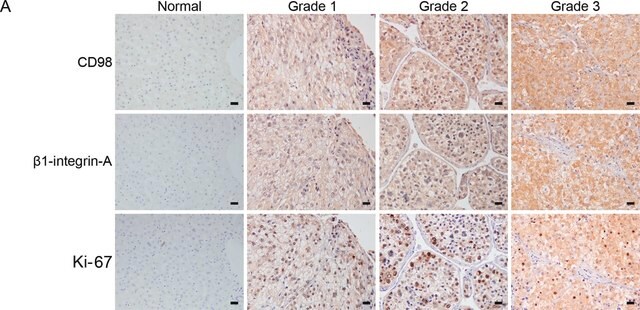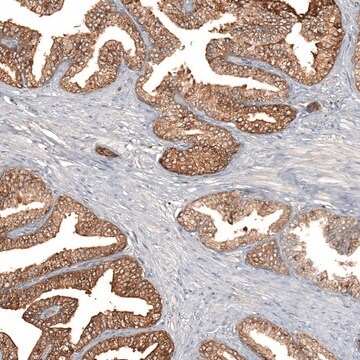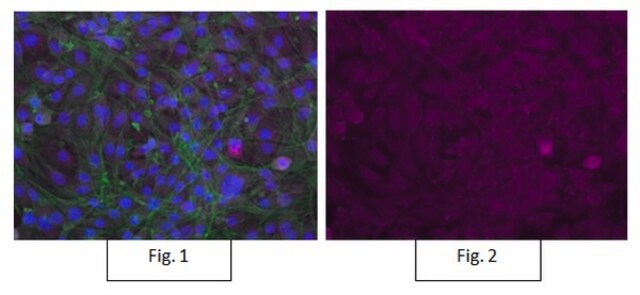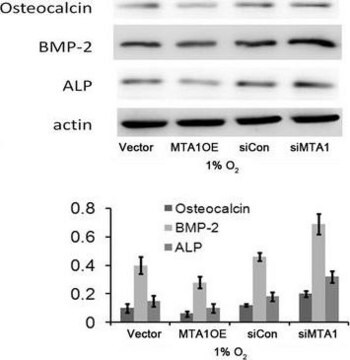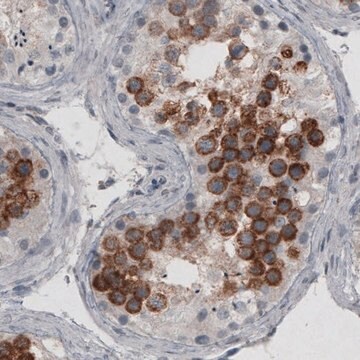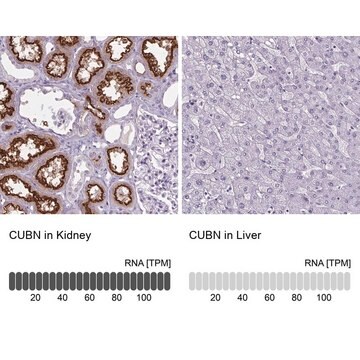推薦產品
生物源
rabbit
品質等級
共軛
unconjugated
抗體表格
purified immunoglobulin
抗體產品種類
primary antibodies
無性繁殖
polyclonal
形狀
buffered aqueous solution
分子量
antigen 73.81 kDa
物種活性
human
技術
western blot: 1 μg/mL
NCBI登錄號
UniProt登錄號
運輸包裝
dry ice
儲存溫度
−20°C
目標翻譯後修改
unmodified
基因資訊
human ... HAP1(9001)
一般說明
Huntington′s disease (HD), a neurodegenerative disorder characterized by loss of striatal neurons, is caused by an expansion of a polyglutamine tract in the HD protein huntingtin. This gene encodes a protein that interacts with huntingtin, with two cytoskeletal proteins (dynactin and pericentriolar autoantigen protein 1), and with a hepatocyte growth factor-regulated tyrosine kinase substrate. The interactions with cytoskeletal proteins and a kinase substrate suggest a role for this protein in vesicular trafficking or organelle transport. Several alternatively spliced transcript variants encoding different isoforms have been described for this gene. (provided by RefSeq)
免疫原
HAP1 (AAI56729.1, 1 a.a. ~ 671 a.a) full-length human protein.
Sequence
MRPKRLGRCCAGSRLGPGDPAALTCAPSPSASPAPEPSAQPQARGTGQRVGSRATSGSQFLSEARTGARPASEAGAKAGARRPSAFSAIQGDVRSMPDNSDAPWTRFVFQGPFGSRATGRGTGKAAGIWKTPAAYVGRRPGVSGPERAAFIRELEEALCPNLPPPVKKITQEDVKVMLYLLEELLPPVWESVTYGMVLQRERDLNTAARIGQSLVKQNSVLMEENSKLEALLGSAKEEILYLRHQVNLRDELLQLYSDSDEEDEDEEEEEEEKEAEEEQEEEEAEEDLQCAHPCDAPKLISQEALLHQHHCPQLEALQEKLRLLEEENHQLREEASQLDTLEDEEQMLILECVEQFSEASQQMAELSEVLVLRLENYERQQQEVARLQAQVLKLQQRCRMYGAETEKLQKQLASEKEIQMQLQEESVWVGSQLQDLREKYMDCGGMLIEMQEEVKTLRQQPPVSTGSATHYPYSVPLETLPGFQETLAEELRTSLRRMISDPVYFMERNYEMPRGDTSSLRYDFRYSEDREQVRGFEAEEGLMLAADIMRGEDFTPAEEFVPQEELGAAKKVPAEEGVMEEAELVSEETEGWEEVELELDEATRMNVVTSALEASGLGPSHLDMNYVLQQLANWQDAHYRRQLRWKMLQKGECPHGALPAASRTSCRSSCR
Sequence
MRPKRLGRCCAGSRLGPGDPAALTCAPSPSASPAPEPSAQPQARGTGQRVGSRATSGSQFLSEARTGARPASEAGAKAGARRPSAFSAIQGDVRSMPDNSDAPWTRFVFQGPFGSRATGRGTGKAAGIWKTPAAYVGRRPGVSGPERAAFIRELEEALCPNLPPPVKKITQEDVKVMLYLLEELLPPVWESVTYGMVLQRERDLNTAARIGQSLVKQNSVLMEENSKLEALLGSAKEEILYLRHQVNLRDELLQLYSDSDEEDEDEEEEEEEKEAEEEQEEEEAEEDLQCAHPCDAPKLISQEALLHQHHCPQLEALQEKLRLLEEENHQLREEASQLDTLEDEEQMLILECVEQFSEASQQMAELSEVLVLRLENYERQQQEVARLQAQVLKLQQRCRMYGAETEKLQKQLASEKEIQMQLQEESVWVGSQLQDLREKYMDCGGMLIEMQEEVKTLRQQPPVSTGSATHYPYSVPLETLPGFQETLAEELRTSLRRMISDPVYFMERNYEMPRGDTSSLRYDFRYSEDREQVRGFEAEEGLMLAADIMRGEDFTPAEEFVPQEELGAAKKVPAEEGVMEEAELVSEETEGWEEVELELDEATRMNVVTSALEASGLGPSHLDMNYVLQQLANWQDAHYRRQLRWKMLQKGECPHGALPAASRTSCRSSCR
生化/生理作用
The gene HAP1 (huntingtin-associated protein 1) is a bifunctional enzyme that functions as a DNA repair enzyme as well as in redox activation of transcription factors. It binds to the Huntington′s disease (HD) protein huntingtin in a polyglutamine length-dependent manner. It associates with huntingtin via the cytoskeletal proteins dynactin and pericentriolar autoantigen protein 1 forming coiled-coils. It plays a role in vesicle trafficking by facilitating interactions among cytoskeletal, vesicular and motor proteins. It is an apurinic/apyrimidinic (AP) site-specific DNA repair endonuclease that removes the AP sites produced naturally or by cytotoxic drugs and radiation. It also has RNAse H activity and controls the redox state of certain proto-oncogene products, such as the transcription factor c-Jun. The HAP1 protein is a candidate for pathology associated with HD.
外觀
Solution in phosphate buffered saline, pH 7.4
未找到適合的產品?
試用我們的產品選擇工具.
儲存類別代碼
10 - Combustible liquids
水污染物質分類(WGK)
WGK 3
閃點(°F)
Not applicable
閃點(°C)
Not applicable
A role for the human DNA repair enzyme HAP1 in cellular protection against DNA damaging agents and hypoxic stress.
Walker LJ
Nucleic Acids Research, 22, 4884-4889 (1994)
Assignment of the huntingtin (Hdh) gene, the huntingtin associated protein (Hap1) gene, and the huntingtin interacting protein (Hip1) gene to rat chromosomes 14, 10, and 12 by radiation hybrid mapping and fluorescent in situ hybridization.
Zimdahl H
Cytogenetics and Cell Genetics, 94, 101-104 (2001)
Huntingtin-associated protein 1 (HAP1) interacts with the p150Glued subunit of dynactin.
Engelender S
Human Molecular Genetics, 6, 2205-2212 (1997)
L J Walker et al.
Molecular and cellular biology, 13(9), 5370-5376 (1993-09-01)
The DNA binding activity of the c-jun proto-oncogene product is inhibited by oxidation of a specific cysteine residue (Cys-252) in the DNA binding domain. Jun protein inactivated by oxidation of this residue can be efficiently reactivated by a factor from
我們的科學家團隊在所有研究領域都有豐富的經驗,包括生命科學、材料科學、化學合成、色譜、分析等.
聯絡技術服務
